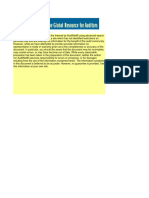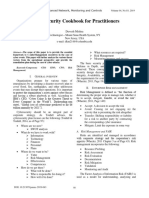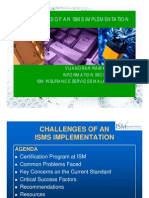0 ratings0% found this document useful (0 votes)
238 viewsDatabase Security Application Checklist Template
The document provides a checklist of 21 action items for secure coding in applications. The checklist includes recommendations for implementing CAPTCHAs, input validation, parameterized queries, access controls, password hashing, error handling, and session management. It also provides guidelines for updating applications, backing up data, and restricting network access. The goal is to help developers incorporate security best practices to protect applications and user data.
Uploaded by
Ivan Estuardo Echeverría CatalánCopyright
© © All Rights Reserved
Available Formats
Download as PDF, TXT or read online on Scribd
0 ratings0% found this document useful (0 votes)
238 viewsDatabase Security Application Checklist Template
The document provides a checklist of 21 action items for secure coding in applications. The checklist includes recommendations for implementing CAPTCHAs, input validation, parameterized queries, access controls, password hashing, error handling, and session management. It also provides guidelines for updating applications, backing up data, and restricting network access. The goal is to help developers incorporate security best practices to protect applications and user data.
Uploaded by
Ivan Estuardo Echeverría CatalánCopyright
© © All Rights Reserved
Available Formats
Download as PDF, TXT or read online on Scribd
You are on page 1/ 3
Checklist for Secure Cod
Code Programming in Applications
S.No. Action Item(s) Is implemented?
1 Implement CAPTCHA on all entry entry-forms in PUBLIC pages. YES NO Not Applicable
Implement CAPTCHA or account
account-lockout feature on the login
form.
[Alpha-numeric CAPTCHA with minimum 6 characters]
2 Implement proper validations on all input parameters in client and YES NO Not Applicable
server side (both).
listing of characters is preferred over Black-listing]
[White-listing
3 Use parameterized queries or Stored
Stored-procedures to query output YES NO Not Applicable
from databases, instead of inline SQL queries
[Prevention of SQL Injection]
4 Implement proper Audit/Action Trails in applications YES NO Not Applicable
5 Use different Pre and Post authentication session
session- YES NO Not Applicable
values/Authentication-cookies
cookies
6 Implement proper Access matrix ((Access Control List-ACL) to YES NO Not Applicable
prevent un-authorized
authorized access to resources/pages/forms in
website
[Prevention of Privilege escalation and restrict in of access to
authorized/authenticated content ]
7 Do not reference components (such as javascript
javascripts,stylesheets etc.) YES NO Not Applicable
directly third-party sites.
[They may be downloaded and self self-referenced in website]
8 Use third-Party
Party components from trusted source only. YES NO Not Applicable
[Components
Components with known vulnerabilities are not recommended.]
9 Store critical data such as PAN number,Mobile Number,A
Number,Aadhar YES NO Not Applicable
Card number
umber etc. in encrypted form in the database.
[Hashing of sensitive information is preferred over encryption,
unless required to be decrypted]
10 Prevent critical information from public access by any mean YES NO Not Applicable
[Critical information
rmation like credit card number, account number,
aadhar number etc. should be restricted to authorized persons
only. If such information is stored in static files such as excel,pdf
etc., sufficient measures shoul
should be taken so that is it not
accessible to unauthorized persons or in public.]
11 Hash the password before it is relayed over network, or is stored YES NO Not Applicable
in database.
[During login, password should be salt salt-hashed using SHA-256/512.
However, it should be stored as plain hash (SHA-256/512) in
database. On every login attempt, new salt should be used, and it
should be generated from server
server-side only]
12 Implement Change Password and Forgot password module in YES NO Not Applicable
applications
[not required in applications, using LDAP for authentication]
13 Comply with Password Policy,, wherever passwords are being used. YES NO Not Applicable
14 Use Post methods to pass parameters as values from one one- YES NO Not Applicable
page/website to another.
[GET methods should be avoided]
15 Implement proper error-handling.
handling. YES NO Not Applicable
[System/application errors sho should not be displayed to viewer]
Application Security Division, Cyber Security Group
National Informatics Centre
A
A-Block, CGO Complex, Lodhi Road,
New Delhi - 110003
16 Implement token-based based system that changes on every web- YES NO Not Applicable
request in application, to prevent CSRF.
[CSRF Guard or Anti-forgery
forgery tokens can be implemented in nonnon-
critical applications. Websites using payment
payment-gateways etc. are
categorized in critical websites.]
17 Do not implement File upload in public modules YES NO Not Applicable
18 Store uploaded
ploaded files in database, rather than storing them in file
file- YES NO Not Applicable
system
[Files,
iles, stored in database cannot be executed directly, hence this is
more secure than storing them in file system.]
19 Generate unique, un-predictable
predictable and non
non-sequential receipt YES NO Not Applicable
numbers/acknowledgement
/acknowledgement numbers/application numbers/roll
numbers/ File-names etc.. It is preferable that strong algorithm be
used to generate such numbers.
20 Implement properroper Session Timeout YES NO Not Applicable
[Logged-In In user should be logged
logged-out after a specific period(say 20
minutes) of inactivity]
21 Assure admin/Super-Admin Admin URL’s is/are accessible from restricted YES NO Not Applicable
IP’s only
[For this, segregate public URL from Admin/Super
Admin/Super-Admin module.
Public modules and Admin/Super
Admin/Super-Admin modules should be
deployed on separate URL’s.
Admin/Super-AdminAdmin URL’s should be accessible from restricted
IP’s only. It is preferable to allow access for Admin/Super
Admin/Super-Admin
modules through VPN]
Other Action Item(s)
1 Assure third-Party links/page(partial/full) open in different tab, YES NO Not Applicable
with a disclaimer.
2 Disable Trace/PUT/DELETE and other non non-required methods in YES NO Not Applicable
application/web-server.
3 Assure that Emaill addresses, where ever used, are in form of an YES NO Not Applicable
image.
[Alternatively, replace “@” with [at] and “.” with [dot] in email
addresses]
4 Disable directory listing YES NO Not Applicable
5 Set “Auto to Complete” off for textboxes in forms YES NO Not Applicable
6 Prevent pages from being stored in history/cache. YES NO Not Applicable
[Each time that the user tries to fetch a page, it should request
server to serve with a fresh copy of the page]
7 Implement Logout buttons in all authenticated pages YES NO Not Applicable
Implementation Guidelines
1 Restrict each application for minimum access (only required YES NO Not Applicable
access)
[Allow access of application for restricted network access
access.
Websites, those are to be used in local
local-network, should not be
accessible from any other network. For exceptional cases, VPN
may be used.
Websites, those are required to be accessed from within the
country,, should be restricted for access on Indian ISP’s ONLY.]
2 Use the latest and non-vulnerable
vulnerable versions of Application Server YES NO Not Applicable
(IIS/Apache etc.), Jqueryetc.
3 Enable audit-trails
trails and system logs on server
[e.g. :Web-Access logs, Application Logs, Security Logs etc.
Application Security Division, Cyber Security Group
National Informatics Centre
A
A-Block, CGO Complex, Lodhi Road,
New Delhi - 110003
4 Take regular backups of data and application YES NO Not Applicable
[Sufficient arrangements should be made to take proper and
regular backups of database,application and other related
objects/components, for retrieval on undesirable circumstances.
It is preferable to maintain a set of last 5 backups.
It is advised to store backups on hard
hard-drive/tape-disks/SAN-
storage. Networked servers/mach
servers/machines should be avoided for this
activity]
For detailed checklist for develo
developers and secure codingguidelines,, visit:
https://security.nic.in/appsec_new.aspx?pid=114&
https://security.nic.in/appsec_new.aspx?pid=114&id=118&index=2
id=118&index=2
Application Security Division, Cyber Security Group
National Informatics Centre
A
A-Block, CGO Complex, Lodhi Road,
New Delhi - 110003
You might also like
- Privileged Access Management Policy Template100% (1)Privileged Access Management Policy Template28 pages
- FINAL-MS Security Baseline Windows Server 2022No ratings yetFINAL-MS Security Baseline Windows Server 20222,146 pages
- 3rd Party Outsourcing Information Security Assessment Questionnaire V1.4No ratings yet3rd Party Outsourcing Information Security Assessment Questionnaire V1.410 pages
- Annexure 3.2 - TPRM Checklist For Collection VendorsNo ratings yetAnnexure 3.2 - TPRM Checklist For Collection Vendors4 pages
- Database Security and Auditing Best Practices PDFNo ratings yetDatabase Security and Auditing Best Practices PDF49 pages
- Secure Development and Managing Technical DebtNo ratings yetSecure Development and Managing Technical Debt66 pages
- SaltSecurity Ebook OWASP API Top10 2023No ratings yetSaltSecurity Ebook OWASP API Top10 202321 pages
- Kiwiqa Services: Web Application Vapt ReportNo ratings yetKiwiqa Services: Web Application Vapt Report25 pages
- 19 1106 Cisa CISA Cyber Essentials S508C 0No ratings yet19 1106 Cisa CISA Cyber Essentials S508C 02 pages
- IT Physical Security Audit Work ProgramNo ratings yetIT Physical Security Audit Work Program49 pages
- Lateral Movement Detection GPO Settings Cheat Sheet: Accounts, Users and Groups100% (1)Lateral Movement Detection GPO Settings Cheat Sheet: Accounts, Users and Groups1 page
- Cyber Capability Toolkit - Cyber Incident Response - Ransomware Playbook v2.3No ratings yetCyber Capability Toolkit - Cyber Incident Response - Ransomware Playbook v2.322 pages
- Cyber Security Cookbook For PractitionerNo ratings yetCyber Security Cookbook For Practitioner18 pages
- ISO 27001 Information Security Policy Template - SecureframeNo ratings yetISO 27001 Information Security Policy Template - Secureframe4 pages
- Best Practices and Lessons Learned From the Microsoft Cyber Defence Operations CentreNo ratings yetBest Practices and Lessons Learned From the Microsoft Cyber Defence Operations Centre41 pages
- Information Security Incident Management PolicyNo ratings yetInformation Security Incident Management Policy10 pages
- Web Application Security Checklist 1685278378100% (1)Web Application Security Checklist 168527837832 pages
- Vijay - Challenges of An ISMS Implementation100% (1)Vijay - Challenges of An ISMS Implementation29 pages
- Threat and Vulnerability Management Policy100% (1)Threat and Vulnerability Management Policy12 pages
- ISMS-DOC-A06-3 Information Security Guidelines For Project ManagementNo ratings yetISMS-DOC-A06-3 Information Security Guidelines For Project Management9 pages
- Network Security Documentation Checklist (2009)100% (2)Network Security Documentation Checklist (2009)3 pages
- Cyber-Security-Risk-Assessment-Matrix-Template-TemplateLab.com_No ratings yetCyber-Security-Risk-Assessment-Matrix-Template-TemplateLab.com_1 page
- Data Center Infrastructure, Storage-Design Guide - SAN Distance Extension Using ISLs - Brocade Community Forums - 36627No ratings yetData Center Infrastructure, Storage-Design Guide - SAN Distance Extension Using ISLs - Brocade Community Forums - 3662711 pages
- IT Infrastructure Security Risk Assessment Using The Center For Internet Security Critical Security Control Framework A Case Study at Insurance CompanyNo ratings yetIT Infrastructure Security Risk Assessment Using The Center For Internet Security Critical Security Control Framework A Case Study at Insurance Company6 pages
- Spotting The Adversary With Windows Event Log MonitoringNo ratings yetSpotting The Adversary With Windows Event Log Monitoring54 pages
- The Business Owner's Guide to Cybersecurity: Protecting Your Company from Online ThreatsFrom EverandThe Business Owner's Guide to Cybersecurity: Protecting Your Company from Online ThreatsNo ratings yet
- Important Points To Consider For Performance Optimization and Security Enhancement of Web ApplicationNo ratings yetImportant Points To Consider For Performance Optimization and Security Enhancement of Web Application6 pages
- Inventario de Activos Informaticos - Iai-Software Servidores Productos Tipo Versión No. LicenciasNo ratings yetInventario de Activos Informaticos - Iai-Software Servidores Productos Tipo Versión No. Licencias5 pages
- Full OEPT G2 - Info Sheet & FAQ (1) (2) (1) (1) (1) (1) (1) (1)No ratings yetFull OEPT G2 - Info Sheet & FAQ (1) (2) (1) (1) (1) (1) (1) (1)5 pages
- Cinema fv-5 The Official User Guide PDFNo ratings yetCinema fv-5 The Official User Guide PDF36 pages
- Lecture 1 Introduction by Dr. Fazeel AbidNo ratings yetLecture 1 Introduction by Dr. Fazeel Abid26 pages
- Course Outline Web Design and DevelopmentNo ratings yetCourse Outline Web Design and Development2 pages
- Be Information Technology Semester 5 2023 December Software Engineeringrev 2019 C SchemeNo ratings yetBe Information Technology Semester 5 2023 December Software Engineeringrev 2019 C Scheme1 page
- Using Avaya H175 Video Collaboration Station: Release 1.0.2 April 2016No ratings yetUsing Avaya H175 Video Collaboration Station: Release 1.0.2 April 2016176 pages
- Writing Good Requirements - Ivy Hooks - 1993No ratings yetWriting Good Requirements - Ivy Hooks - 199311 pages






























































































